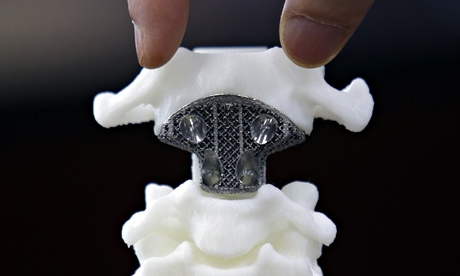
False teeth, hip joints and replacement knees – and potentially printable skin and organs – will drive growth in the burgeoning market for 3D printers over the next decade, according to new research.
A report suggests that dentistry and medicine will increasingly harness one of the 21st century's most exciting technological breakthroughs.
The technology is better known to British households for its ability to replace broken crockery or produce awkward figurine "selfies."
But a report by Cambridge-based market research firm IDTechEx says ceramic jaw or teeth implants and metal hip replacements will become increasingly common 3D fare.
The parts are created by nozzles laying down fine sedimentary layers of material that build a product indistinguishable from an item that has rolled off a factory conveyor belt.
The dental and medical market for 3D printers is expected to expand by 365% to $867m (£523m) by 2025, according to IDTechEx analysts, even before bio-printing technology is taken into account. If bio-printing becomes suitable for commercial use – which scientists hope will allow the printing of pieces of skin, liver or kidney using live cells – analysts estimate the medical market could reach a value of $6bn or more within 10 years.
While printing of complete organs for transplants may be decades away, the use of pieces of tissue for laboratory toxicology tests for cosmetics or drugs could be ready within five years, helping the medical market for 3D printers overtake all other sectors.
Dr Jon Harrop, a director of IDTechEx, said: "Bio printing is a bit unsure as it doesn't exist commercially at the moment but all the medical professionals we interviewed thought it was highly likely to be commercial within 10 years."
In the US, dental labs have invested in technology that can scan a patient's teeth so new teeth can be produced by pressing the print button.
Harrop said there are a number of stumbling blocks in the way of the commercial application of bio printing, but even in the past year, scientists have been able to extend the life of a piece of skin tissue created in the lab from just a few hours to 40 days, taking it closer to the three months required for toxicology tests.
At present, 3D printers are most widely used in the automotive industry where they help produce prototypes for new cars or car parts. The next biggest market is aerospace, where manufacturers are using the technology to make lighter versions of complex parts for aeroplanes.
Already, 3D printers have been used by the medical industry to create a jaw, a pelvis and several customised hip replacements from metal. This year, surgeons in Newcastle upon Tyne created a titanium pelvis for a man who lost half his original one to a rare bone cancer, while in May doctors in Southampton completed Britain's first hip replacement made using a 3D printer. Professor Richard Oreffo at the University of Southampton, who helped develop the hip replacement technique, said at the time: "The 3D printing of the implant in titanium, from CT scans of the patient and stem cell graft, is cutting edge and offers the possibility of improved outcomes for patients."
Dentists have been using 3D printers to create exact replicas of jaws or teeth in order to aid complex procedures for a few years, but increasingly they are creating implants made of durable plastic or medical ceramics.

